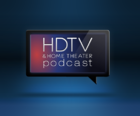 Mar 23
Mar 23 Podcast #836: Short Throw Projectors
 Podcast Tags:
Podcast Tags:  Home Theater,
Home Theater,  Projector,
Projector,  Short Throw
Short Throw  There was a short throw projector on Woot! this week for $999. Not a bad price at all for the potential to have a 100” television in your family room or home theater. That got us thinking… Why aren’t more people using short throw projectors in their homes? Their price per square inch of screen real estate is by far the most cost effective way to get a huge screen at home, and the install and setup is a snap. So what gives? Why aren’t people using them.
There was a short throw projector on Woot! this week for $999. Not a bad price at all for the potential to have a 100” television in your family room or home theater. That got us thinking… Why aren’t more people using short throw projectors in their homes? Their price per square inch of screen real estate is by far the most cost effective way to get a huge screen at home, and the install and setup is a snap. So what gives? Why aren’t people using them.
| Download this Episode. |
Support the show with Patreon!
Check out the OC Reclaimed Treasures at their Etsy Shop
Listen to the show
Today's Show:
News:
- Apple reportedly eyes making its own MicroLED screens
- Roku Channel makes its way to Samsung smart TVs
- Live TV drives cable customers to stay
Other:
- Cnet: Best upgrades for the money
- Requesting listener feedback on Ambiscreen or Dreamscreen for bias lighting
- Moen IO Digital Smart Shower
Amazon Prime:
Sign up for Amazon Prime and enjoy:
- Free Two Day Shipping!
- Instant Streaming of TV Shows and Movies
- Instant Access to thousands of Kindle Books
- The HT Guys gratitude!
Short Throw Projectors
There was a short throw projector on Woot! this week for $999. Not a bad price at all for the potential to have a 100” television in your family room or home theater. That got us thinking… Why aren’t more people using short throw projectors in their homes? Their price per square inch of screen real estate is by far the most cost effective way to get a huge screen at home, and the install and setup is a snap. So what gives? Why aren’t people using them.
Let us first apologize if some of you reading or listening are using short throw projectors at home. We aren’t saying that you are not a person. We’re simply saying that to date, we haven’t seen a short throw projector in use in any home we’ve ever been to, nor have we had anyone brag to us about how cool their short throw setup is. We’re going to take a look at some pros and cons and see if we can come up with theories on why they haven’t caught on. If you have one, or have had one in the past and decided to ditch it, we’d love to hear your take.
What is it
For those who don’t know, a short throw projector is a home theater projector that, like a standard front projection system, can give you a very large display area in your home, often maxing out at 100” to 120”. The big difference is that they bounce the image off a mirror or two and project that large screen from only a few inches or a couple feet from the screen itself, not from all the way in the back of the room. So you get a huge home cinema by placing the projector on a standard TV stand at the front of your living room, in the same place you might put a center speaker or a soundbar.
*Aside: Remember the old school big screen CRTs that would fold down or you’d pull a box out into the room to beam the image up onto the screen? It’s kinda like that. Only not.
Pros and Cons
The pros are obvious: the cost to purchase a 100” or 120” television is astronomical - unattainable for most of us regular folk. So the only way to get a home theater that size is with a projector. But projectors are difficult to install, often requiring a professional to run cables and power to the back of the room. But with a short throw, there’s not need to run anything to the back of the room. You just set them on your TV cabinet and hook them up like you would any other television. No install cost, low projector cost, instant home theater.
The cons, as you can image, are nearly identical to the cons for typical from projection systems. In both cases, most are 1080p still. While prices for 4k are dropping, the are still at a good premium and selection is limited. Also, both suffer from a lack of overall brightness, making the ability to control ambient light critical, especially for daytime viewing. If you have a bright room with a bunch of windows, most projectors, including short throw projectors, will be frustrating to use during the day.
And projectors require screens. You can’t really just beam the picture onto a wall and expect to be happy with the picture. That means a second product to buy and install, increasing the complexity of the overall system. On top of that, many short throw projectors require a special screen that has been built to match the projector. At least with typical front projection you can buy and install whatever screen you like. Not so with some short throw setups. Probably the only con that short throw projectors don’t share with standard front projectors is that people can walk through the beam and block it from getting to the screen. Unless people routinely walk on your TV cabinet, you won’t have that issue with a short throw.
Options
LG PF1000UW
The short throw projector we saw on Woot! for $999 was the LG PF1000UW Ultra Short Throw Smart LED Projector with webOS 3.0 Smart TV and Magic Remote. The specs sound pretty compelling, even for dedicated home theater use, not just portable or temporary instant home theater for backyards or parties or other events. With webOS 3.0 built in, it’s like buying a Smart TV, just with a bigger screen.
The throw distance is really short; at just 5 inches away you can get 60 inches of home theater, or go to 15 inches back to get images up to 100 inches on screen. And it has a max brightness of 1000 lumen. You get full HD 1080p picture quality. We would have loved 4k, but 1080p is good too. The LED lamp is very efficient and will last up to an estimated 30,000 hours. That means the lamp does not have to be replaced for about 10 years if the projector is used 8 hours every day. And it has 4-corner keystone technology that allows for adjustment of each of the four corners of the image for ideal projection image alignment.
LG PF1000UW: $1399 MSRP
LG also makes the HF85JA with 1500 lumens for a $1599 suggested price and the PH450U with 450 lumens for a $599 street (Amazon) price.
Optoma EH320UST
The Optoma Ultra Short Throw 3D 1080p Projector EH320UST is another option in this category. This option is impressively bright. It can hit a peak brightness of 4000 ANSI lumens. You get full HD 1080p resolution, 20,000:1 contrast ratio and it can also display true 3D content. They claim a long lamp life citing up to 6,500 hours, which is great, but not exactly the 30,000 hours you can get from LG. And this one can project a 100” image from just 21 inches away.
Optoma EH320UST: $1564 street (Amazon)
NEC NP-UM351W
Nearly as bright as the Optoma, this unit from NEC gets up to 3500 lumens bright. Both are pretty close to good daytime viewing. It has a special Ultra short throw lens (0.36:1 throw ratio) helps eliminate shadows on the screen along with projected light in the presenter’s eyes created by traditional front projection systems. It also has Horizontal & Vertical Keystone adjustment or Cornerstone Correction to ensures the image will fill the screen and won’t be distorted at the edges.
NEC NP-UM351W: $1092 street (Amazon)
ViewSonic PX800HD
The ViewSonic PX800HD has ViewSonic's Super Color True Cinema RGBRGB technology, this projector delivers calibrated color accuracy for brilliant, true-to-life images. With a 0.23 ultra-short throw lens, this projector can be placed just inches away from a wall or screen to give you a huge image up to 150”. In addition to the simplicity and convenience of ultra-short throw projection, the Port All compartment is specially designed for wireless streaming devices and PC sticks. Perfectly paired with a View Sonic BCP100 or BCP120 ambient light diffusing screen (sold separately), the PX800HD delivers a brilliant and supersized cinema experience that LED TVs can't match.
ViewSonic PX800HD: $1299
Conclusion
For anyone that wants a 100 inch or larger screen, without having to run any cables to the back of the room, the short throw projector sure feels like the perfect fit. We’re at a loss on why they aren’t more popular. Have an opinion on them or direct knowledge of them? Fire off an email or drop a comment on the web page. Could be that the lack of enthusiasm or market penetration is due to incredibly poor marketing. Or maybe most people just don’t have a wall big enough to accomodate a 100” screen. Who knows?


Reader Comments (1)
I disagree that a 4K HDR TV will make little difference to non 4K HDR content. I have a LG 55" OLED HDR TV and I see the difference on every source, whether it be BluRay, OTA, satellite, YouTube TV, Netflix, etc. The colours and contrasts are more realistic, specular highlights are more obvious.
My previous TV was a plasma which gave me top quality image. But after the switch everything was different. Even my wife, who is not into this stuff, asked me why was it that a scene we were watching of a Netflix show looked 3D. The TV does a great job simulating HDR, though occasionally overdoing it. I use the Expert modes, not the (simulate) HDR Effects modes.